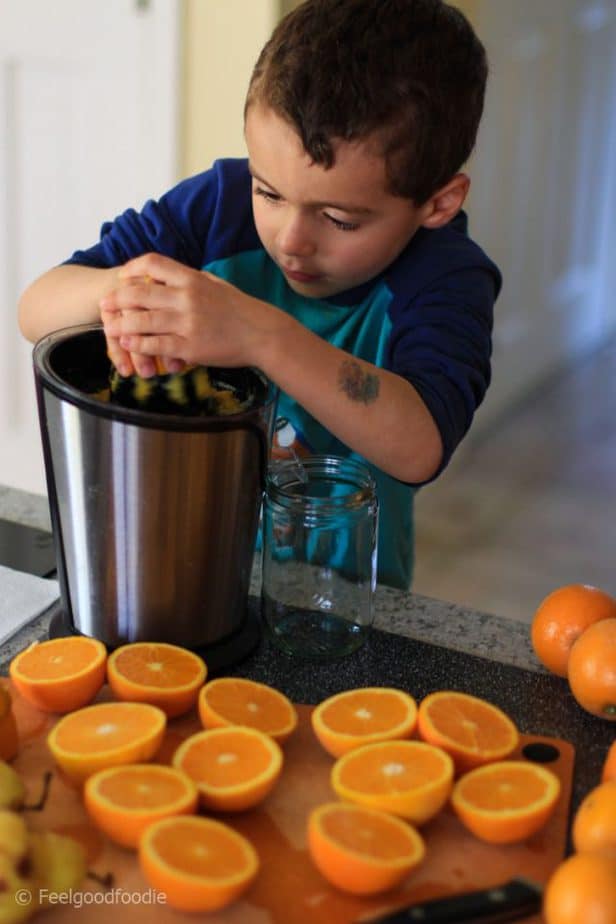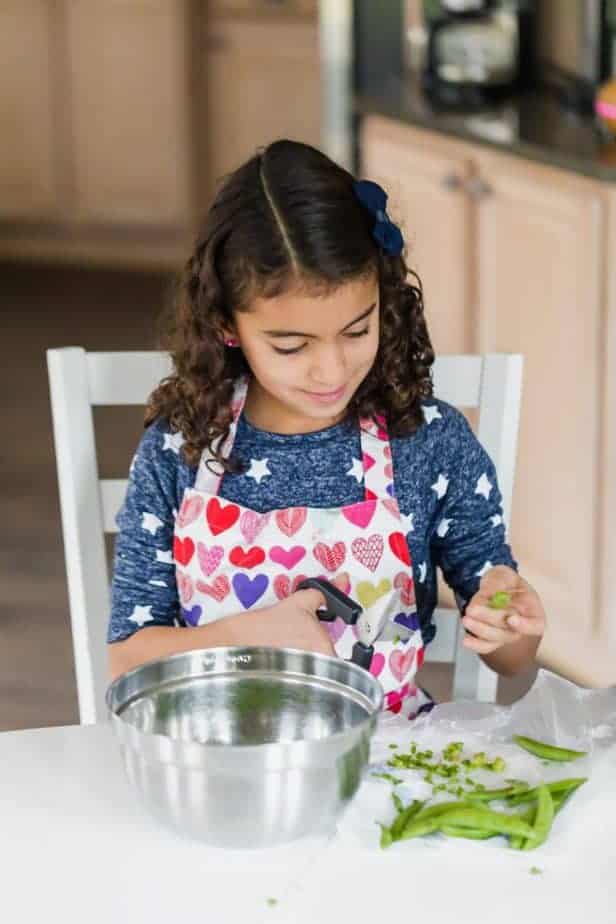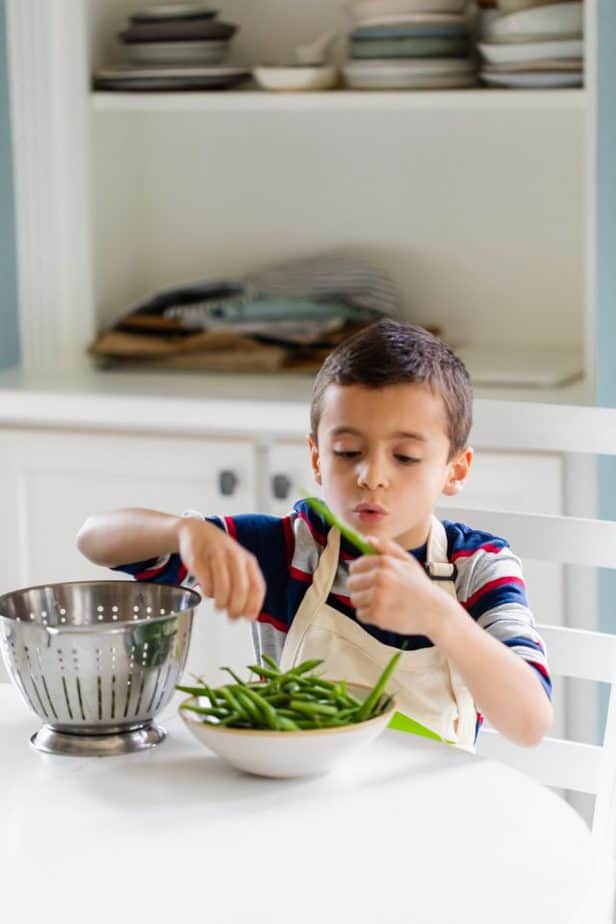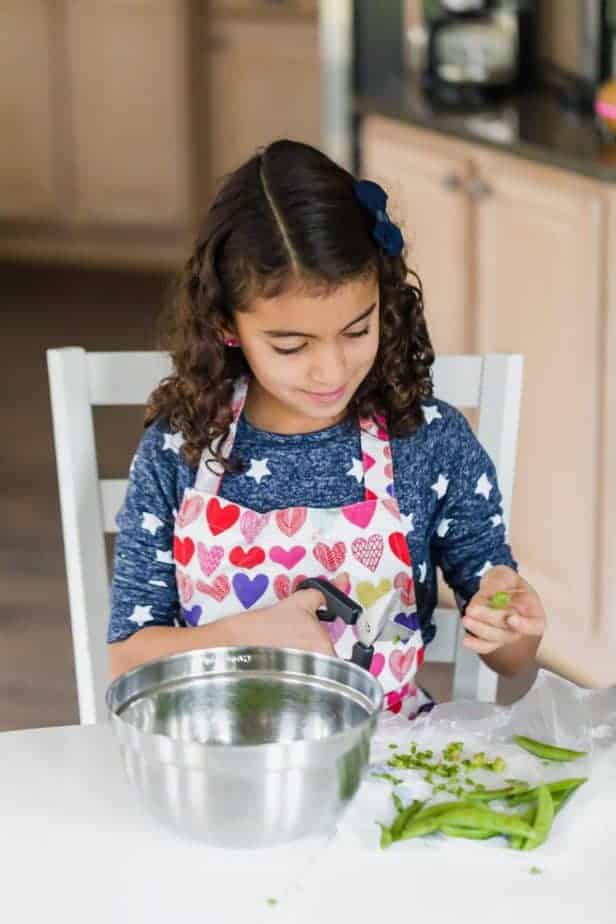This post may contain affiliate links. Please read our disclosure policy.
As a mom, cooking with my kids is one of my favorite ways to bond with them. So, I’m sharing my guide for how I’ve involved them in the kitchen since they were babies! Aside from learning how to clean, prep, and cook, there are so many more monumental life lessons that kids can learn in the kitchen. These fun and easy recipes will get your kids in the kitchen!

At their Montessori school, my kids’ curriculum stresses educating the whole child. A huge part of the Montessori philosophy is guiding (and expecting) kids to be active citizens of their households by cleaning up and yes, cooking. You’d be surprised how much they can do if you just let them.
These tips and tricks are ones I’ve used for cooking with my kids at home and it means that time spent in the kitchen is fun and enjoyable.
Be sure to grab my list of easy recipes for kids at the bottom of this post for breakfasts, lunches, dinners and desserts your kids can help you make.
Why is cooking good for children’s development?
It would almost easier to say why cooking isn’t good for your kids, but here are a few of the awesome benefits:
- It’s a hands-on multi-sensory experience where they see, touch, and smell the ingredients and the finished food.
- Either reading (or being read) the recipe introduces new vocabulary words. The smallest, nonreaders can help turn pages of a cookbook, or hold a recipe printout.
- Math concepts of all levels are used. For instance, the smallest kids can count ingredients like apples or eggs while older kids can do the math to divide a recipe in half or double it.
- Small motor skills are used to pour, mix, and cut food.
- They learn about following directions.
- Children can develop an intimate relationship and an appreciation for food – where it comes from and how it is prepared – as you talk them through a recipe.
- Preparing food outside your family’s immediate traditions teaches about different cultures and geography.
- Working with food encourages children to try different foods beyond the pressure of the dinner table.
- Kids get a sense of satisfaction and confidence from contributing to something important – a family meal!
- Food prepared and eaten around the family table fosters fellowship and social skills.
Age-appropriate cooking ideas
One of my favorite resources for Montessori living is the work – the website, book, and podcasts – of Dutch Montessori teacher Simone Davies. She outlines age-appropriate activities for our mini cooks. Below are her suggestions, which are also found here and some from my own experience.
Under 1 year old
This is really a time for the baby to experience with their five senses. They’re not actually helping in the kitchen, but more so observing you in the kitchen. Start by:
- Describing what the baby is seeing, smelling, and hearing. This can actually encourage optimal brain development.
- Letting your baby taste the food you are working with, when developmentally appropriate
- Letting your baby touch the food you are working with and describe its texture
- Situating your baby in a high chair or carrier so they can watch what you are doing in the kitchen, if doable and safe
- Placing lettuce and fruits in a bowl of water for them to pre-wash
1-2 year olds
It is surprising until you have seen it, but children this young can really start doing things. Here are some activities your kids can try:
- Using a dull knife or spreader to cover crackers or bread with butter, nut butter, or jam
- Peeling and slicing fruit like bananas with a banana slicer
- Shelling peas
- Peeling and slicing hard-boiled eggs
- Adding and mixing ingredients in batters, salads, and other recipes
- Kneading dough
- Pouring water for drinking – if you have a dispenser they can reach or a child-sized water pitcher. This was something my kids absolutely loved!
- Helping to set the table – have dishes where your kids can reach them
- Plating – placing cut-up fruits and vegetables on a platter, whether it is for their own serving or for the whole family
2-3 year old
As their motor skills and attention spans increase, kids are capable of:
- Squeezing orange or other citrus juices
- Using an apple slicer to cut apples
- Using a butter knife to slice soft vegetables like a cucumber
- Whisking eggs for scrambled eggs or frittatas or dry ingredients for baking with a hand whisk
- Grating cheese
- Preparing cereal for breakfast. Keep a scoop in the cereal box; have a small jug with a little milk in it
- Spinning salad to dry it out with a salad spinner – my kids love this!
- Peeling the outer skins off onions and garlic
3-5 year old
This is when cooking with kids really gets fun and when they start to really ask to be in the kitchen. So get them helping by:
- Using some kitchen appliances with supervision – throwing fruits and vegetables in a juicer used to bring so much thrill to my kids!
- Using scales and measuring ingredients with measuring cups and spoons
- Using plastic knives to cut soft fruits and vegetables like strawberries or cucumbers
- Following simple recipes with you
- Fetching ingredients from the fridge or pantry
5-7 year olds
There is a lot of independence at this age and you start to depend on the kids to provide help in the kitchen. Kids this age can try:
- Making their own smoothies by throwing their ingredients in a small blender, covering the lid and pressing start. I have a mini 14-ounce blender (affiliate link) that is the designated kid blender.
- Using a mini table scraper or sweeper to clean up crumbs and messes
- Helping you operate simple appliances with supervision, for example setting the speed on a hand mixer or punching in time on the Instant Pot
- Assisting with meal planning or helping select favorite foods at the grocery store or farmer’s market.
- Following more complicated recipes
- Experimenting (within reason) with riffing on favorite recipes – adding chocolate chips to banana bread, making a favorite dip to serve with vegetables
7 to 9 and beyond
This is the current age of my two kids and I’m having so much fun with them in the kitchen now. I’m constantly trying to teach them new things to try and learning that they are capable of so much more than we might imagine at first . Some of their favorite activities include:
- Using a vegetable peeler to peel root vegetables like potatoes and carrots
- Sweeping the kitchen and dining room floor after dinner
- Wiping the kitchen table or kitchen counter after prepping or after dinner
- Collecting the dishes from the dining table and grouping them in the sink
- Rinsing plates and cups to place in the dishwasher
- Emptying out the dishwasher and sorting the dishes and glassware
- Preparing their own lunches for school

Tips for cooking with kids
- Set up the kitchen so developmentally appropriate activities are possible. For instance, if you want your five-year-old to set the table, make sure the placemats, silverware, and napkins are all in lower drawers or bins accessible in a simple way.
- Store kid-sized kitchen equipment in kid-accessible spaces. Hang their aprons on a low hook and keep their water glasses on a lower shelf.
- Be patient and realistic. Know that not every meal will be a full-on learning experience, but take advantage of what you can. Some days may include more tasks than others.
- Keep safety in mind. Always be between your child and the stove. Stress the power of various appliances like blenders and food processors and supervise when they start using nylon knives and peelers or cutters.
- Expect a mess. Things will fall on the floor and you should lay the expectation that they should clean up their mess. Having small brooms, wipes or dustbins and other child-sized tools will help enforce that message.
Favorite kitchen gadgets for kids
With my two kids in the kitchen, these are our top 15 favorite kitchen items and gadgets that we use very regularly. I’ve linked to them on Amazon (affiliate links).
- Apple slicer: Using two hands, most kids as young as 3 can push down on the handles to safely slice the apples into wedges.
- Egg slicer: The same for hard-boiled eggs.
- Nylon knife: For kids age four and up, a serrated knife with a blunt tip manages to be both safe and effective for cutting cheese, bread, and some fruits and vegetables. Before that they can use a blunt knife to easily spread things like peanut butter or cut fruits like bananas
- Small whisks: For child-sized hands but they do double duty for adults whisking small jobs like salad dressing and sauces
- Wavy chopper: a nice wide handle for small hands to take a two-handed grip to cut veggies and fruit in fun crinkle-cuts
- Colorful measuring spoons, cups and nesting bowls: A different color for each size makes it easy for adults to give direction – “fill the red cup with flour” – and kids to learn sizes by association.
- Cookie cutters: Use them on more than cookies dough! Cut cheese, bread, and other food into fun shapes, too.
- Vegetable peeler: Once they have some practice, having “sous chefs” peel and chop saves time when trying to get dinner on the table. My son is our designated carrots and potato peeler!
- Herb stripper: Picking the leaves off of herbs is a fiddly job for even the most coordinated adult. Pulling stalks through an herb stripper is fun.
- Egg timer: For keeping track of time and learning numbers and time.
- Salad spinner: Even the youngest can use this and it’s so fun to watch it spin.
- Kid -Size Mittens & Aprons: The proper gear keeps everyone clean, safe, and makes kids feel part of things.
- Step Ladder: It can be as fancy like a simple as a basic step stool from the hardware store.

Frequently asked questions
The best way to make it fun is by introducing new gadgets to your kids at different stages, allowing them to select which tasks they’d like to help with and giving them autonomy wherever possible!
It depends on their age. For younger children, washing vegetables can be a lot like water play without it feeling like a chore. Entice an older child into helping make their favorite dish. Play pretend cooking show or even film an episode or Instagram story. Emphasize positives like how much you love eating what you made or how happy you are to be together.
It’s all about choosing age-appropriate activities and setting up for success. It might take some reorganizing to make the kitchen a place for you and your children to cook. And be realistic. It might rightly stress you out to have your child help you with one task, but he could be set up near you doing another task.
Favorite recipes to cook with kids
- Grilled Cheese Dippers
- Pasta in a Mug
- Pancake Dippers
- Homemade Poptarts
- Healthy Muffins
- Frankenguac
- Ravioli Soup
- Cheese Stuffed Shells
- Apple Cinnamon Oatmeal Cups
- Cucumber Sushi
- Pizza Quinoa Bites
- Pink Pancakes
- Watermelon Pizza
- Macaroni Salad
- Breakfasts Ideas For Kids To Make
It definitely takes organization and parental effort to supervise kids in the kitchen. With the proper practice and guidance though, they can become the best sous-chefs. And the payoff of cooking with kids – like when you get a Mother’s Day brunch made solely by the kids using skills you know you taught them – is so worth it.
For more cooking resources:
- How to Stock your Pantry
- How to Stock a Freezer
- How to Cook with Canned Tomatoes
- 16 Pantry Meal Ideas
- 15 Easy No Bake Desserts
- 10 Recipes with Vegetable Broth
- Daily Breakfast Ideas to Stay Healthy
If you find this guide for Cooking with Kids useful, I’d love to hear from you! And if you snapped some shots of any of these tips and tricks, please share it with me on Instagram so I can repost on my stories!






